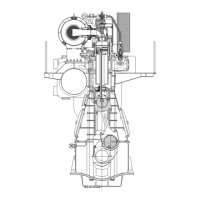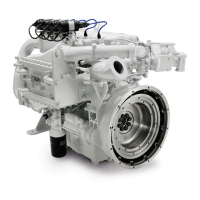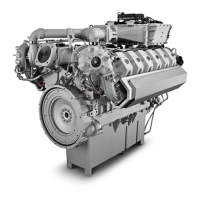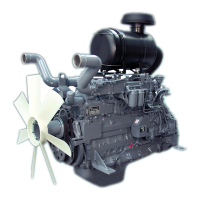MAN B&W 16.01
Page of 8
MAN Diesel
MAN B&W ME/MEC engines 198 48 476.5
Engine Control System ME
The Engine Control System for the ME engine is
prepared for conventional remote control, having
an interface to the Bridge Control system and the
Local Operating Panel (LOP). The LOP replaces
the Engine Side Control console of the MC en-
gines.
A Multi-Purpose Controller (MPC) is applied as
control unit for specic tasks described below:
ACU, CCU, ECU, and EICU. The control units are
all built on the same identical piece of hardware
and differ only in the software installed.
The layout of the Engine Control System is shown
in Fig. 6.0.0, the mechanicalhydraulic system
is shown in Fig. 6.0.02, and the pneumatic sys-
tem, shown in Fig. 6.0.03.
The present ME system has a high level of redun-
dancy. It has been a requirement to its design that
no single failure related to the system may cause
the engine to stop. Furthermore, the ME system
has been designed so that a single failure in most
cases will not, or only slightly, affect the perform-
ance or power availability.
Main Operating Panel (MOP)
In the engine control room a MOP screen is lo-
cated, which is a Personal Computer with a touch
screen as well as a trackball from where the engi-
neer can carry out engine commands, adjust the
engine parameters, select the running modes, and
observe the status of the control system.
A conventional marine approved PC is also lo-
cated in the engine control room serving as a
backup unit for the MOP.
Engine Control Unit (ECU)
For redundancy purposes, the control system
comprises two ECUs operating in parallel and
performing the same task, one being a hot
standby for the other. If one of the ECUs fail, the
other unit will take over the control without any
interruption.
The ECUs perform such tasks as:
• Speed governor functions, start/stop sequenc-
es, timing of fuel injection, timing of exhaust
valve activation, timing of starting valves, etc.
• Continuous running control of auxiliary func-
tions handled by the ACUs
• Alternative running modes and programs.
Cylinder Control Unit (CCU)
The control system includes one CCU per cyl-
inder. The CCU controls the electronic exhaust
Valve Activation (FIVA) and the Starting Air Valves
(SAV), in accordance with the commands received
from the ECU.
All the CCUs are identical, and in the event of a
failure of the CCU for one cylinder only this cylin-
der will automatically be put out of operation.
It should be noted that any electronic part could
be replaced without stopping the engine, which
will revert to normal operation immediately after
the replacement of the defective unit.
Auxiliary Control Unit (ACU)
The control of the auxiliary equipment on the en-
gine is normally divided among three ACUs so
that, in the event of a failure of one unit, there is
sufcient redundancy to permit continuous opera-
tion of the engine.
The ACUs perform the control of the auxiliary
blowers, the control of the electrically and engine
driven hydraulic oil pumps of the Hydraulic Power
Supply (HPS) unit, etc.
Engine Interface Control Unit (EICU)
The EICUs installed in the engine control room
perform such tasks as interface with the sur-
rounding control systems, See Fig. 6.0.0. The
two redundant EICU units operate in parallel.
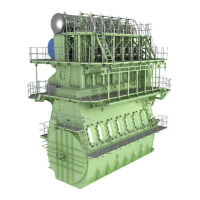
